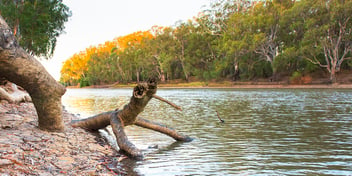MDBA amps up strategy to protect environmental water
The Murray-Darling Basin Authority (MDBA) is trialling remote sensing data to track environmental flow through the Barwon-Darling Rivers in a bid to monitor and protect environmental water in the region.
The flow started in mid-April and is expected to reach Wilcannia by late May.
MDBA Executive Director of Compliance Russell James said its compliance officers will use satellite imagery to trial how flows can be tracked through the system with real-time data.
"These flows have been released at a key time for the health of the system, and have the potential to get really good ecological outcomes. Remote sensing will capture satellite images to give us a clear picture of how the water is flowing through the system and whether there are any inconsistencies,” he said.
"This data may also have potential to measure the success of the flow in maintaining ecologically important connectivity between different parts of the river system.
"We committed in our 2017 review of compliance to explore the potential of new and emerging technologies to support compliance activities and protection of environmental flows, particularly in unregulated systems like in the northern Basin.”
James said the MDBA will complete an internal review, which will be available as a source of information for future compliance activities.
"The NSW Government has placed an embargo on this particular flow, to ensure it makes its way through the system,” he said.
"We'll also complete an internal review after the event to analyse the benefits of remote sensing and how it can be applied for future compliance activities and watering events. Our report on this project will be published on our website."
MDBA Executive Director Carl Binning added that the recent The Living Murray program report showed environmental flows are having a tangible, positive impact on monitored icon sites.
"This is the first time we've been able to look back and see how the icon sites have responded to both the initial delivery of environmental water and also the addition of infrastructure works to make that delivery more efficient and effective,” Binning said.
"Importantly, the evidence is showing that water alone is not enough to achieve environmental change of the magnitude needed to secure the future health of the Basin system.
“We also need works and other reforms – like those tied to the Basin Plan amendment currently before Parliament – to improve our ability to get environmental water to where it's needed, at the right time and in the right volume.”
Since monitoring started in 2007, some sites, including Gunbower Forest, Chowilla Floodplain and Hattah Lakes, have reached six or more of the 11 ecological objectives set.
Other sites including Koondrook-Perricoota, Lindsay, Mulcra and Wallpolla Islands, Lower Lakes, Coorong and Murray Mouth have had less stable improvement, but still show great improvements from initial data.
The MDBA has recently ramped up its efforts in the Basin.
This follows news in late February, that the Murray-Darling Basin was subject to political friction following the announcement that Plan amendments affecting the northern part of the Basin were disallowed by the Australian Parliament.
In March, the NSW Ombudsman started procedures to prosecute irrigators involved in the theft of Murray-Darling Basin water, following months of criticism that the regulator was providing inflated numbers of enforcement actions.
A month later, in a bid to connect river systems across the northern Murray-Darling Basin following a dry start to 2018, the Commonwealth and NSW Government sanctioned environmental water releases into northern waterways.
Most recently, the authority welcomed a range of government commitments, with the passage of two sets of amendments to the Basin Plan passed by Senate.

